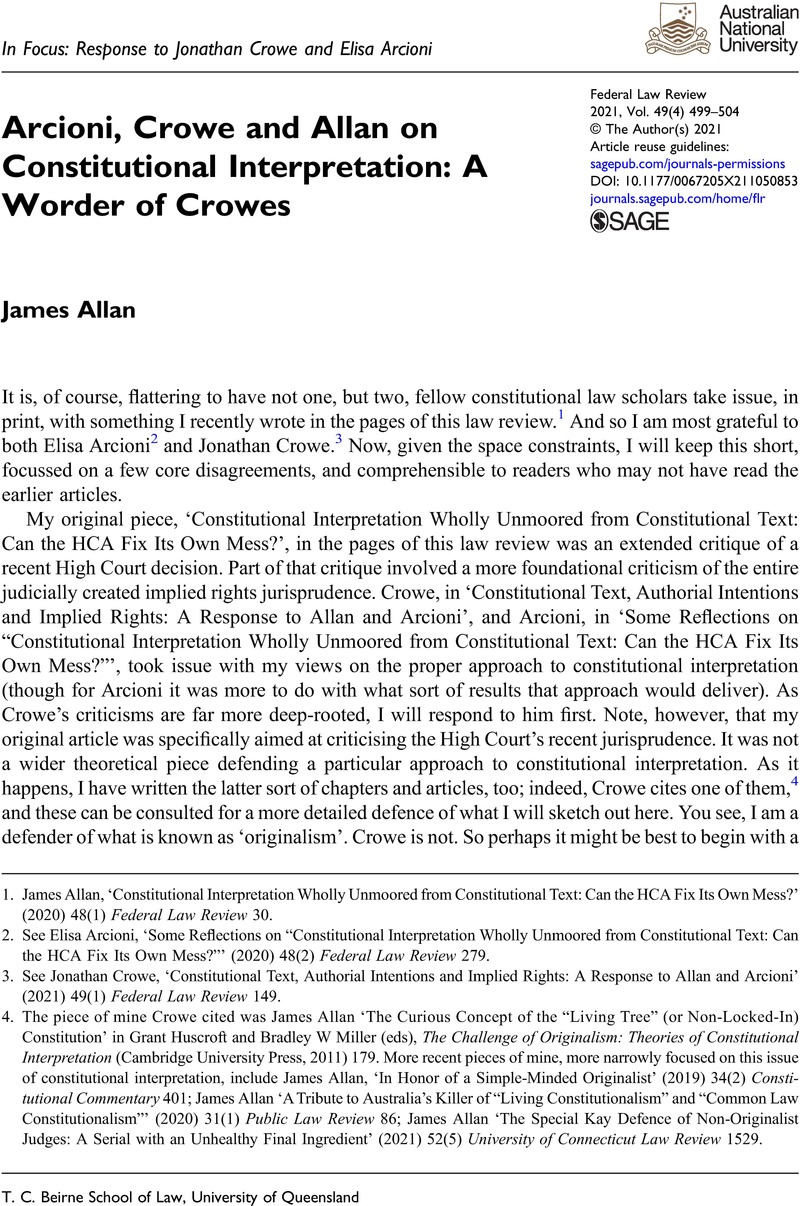No CrossRef data available.
Published online by Cambridge University Press: 01 January 2025

1. James Allan, ‘Constitutional Interpretation Wholly Unmoored from Constitutional Text: Can the HCA Fix Its Own Mess?’ (2020) 48(1) Federal Law Review 30.
2. See Elisa Arcioni, ‘Some Reflections on “Constitutional Interpretation Wholly Unmoored from Constitutional Text: Can the HCA Fix Its Own Mess?”’ (2020) 48(2) Federal Law Review 279.
3. See Jonathan Crowe, ‘Constitutional Text, Authorial Intentions and Implied Rights: A Response to Allan and Arcioni’ (2021) 49(1) Federal Law Review 149.
4. The piece of mine Crowe cited was James Allan ‘The Curious Concept of the “Living Tree” (or Non-Locked-In) Constitution’ in Grant Huscroft and Bradley W Miller (eds), The Challenge of Originalism: Theories of Constitutional Interpretation (Cambridge University Press, 2011) 179. More recent pieces of mine, more narrowly focused on this issue of constitutional interpretation, include James Allan, ‘In Honor of a Simple-Minded Originalist’ (2019) 34(2) Constitutional Commentary 401; James Allan ‘A Tribute to Australia’s Killer of “Living Constitutionalism” and “Common Law Constitutionalism”’ (2020) 31(1) Public Law Review 86; James Allan ‘The Special Kay Defence of Non-Originalist Judges: A Serial with an Unhealthy Final Ingredient’ (2021) 52(5) University of Connecticut Law Review 1529.
5. And general, it will have to be. Far more detail can be found in the various other chapters in Huscroft and Miller (eds) (n 4).
6. See Allan ‘In Honor of a Simple-Minded Originalist’ (n 4), for a full argument to this effect.
7. This same point is made in blunt and unequivocal terms in Richard Kay, ‘Democracy, Mixed Government and Judicial Review’ in Lisa Crawford, Patrick Emerton and Dale Smith (eds), Law Under a Democratic Constitution (Hart Publishing, 2019) 199, 221 inter alia.
8. And who, Larry Alexander points out, always expect you to read their judgements in originalist terms, even their group decisions. These judges assume they will be read in line with their intended meanings. See Larry Alexander, ‘Simple-Minded Originalism’ in Grant Huscroft and Bradley W Miller (eds), The Challenge of Originalism: Theories of Constitutional Interpretation (Cambridge University Press, 2011) 87.
9. Crowe (n 3) 3.
10. As I argue in James Allan, ‘Human Rights, Doubts and Democracy’ in Tom Campbell and Kylie Bourne (eds), The Political Approach to Human Rights (Routledge, 2018) 113, 113-130 and James Allan, Sympathy and Antipathy: Essays Legal and Philosophical (Ashgate, 2002).
11. Crowe (n 3) 3 (emphasis omitted).
12. For a powerful argument to this effect see Stanley Fish, ‘The Intentionalist Thesis Once More’ in Grant Huscroft and Bradley W Miller (eds), The Challenge of Originalism: Theories of Constitutional Interpretation (Cambridge University Press, 2011) 99.
13. Crowe (n 3) 3.
14. See Kay (n 7).
15. Crowe (n 3) 4.
16. Ibid 5.
17. Ibid.
18. For further argument to this effect see James Allan ‘In Honor of a Simple-Minded Originalist’ (2019) 34(2) Constitutional Commentary 401. See, too, Brian Bix ‘Constitutions, Originalism, and Meaning’in Grant Huscroft and Bradley W Miller (eds), The Challenge of Originalism: Theories of Constitutional Interpretation (Cambridge University Press, 2011) 285 and Steven Smith, ‘That Old-Time Originalism’ in Grant Huscroft and Bradley W Miller (eds), The Challenge of Originalism: Theories of Constitutional Interpretation (Cambridge University Press, 2011) 223. This is why all examples of disaggregating them (including those given by Crowe) are always in the empirical realm.
19. It is perhaps just a curiosity that since the initial cases in 1992 that ‘discovered’ these implied freedoms, where Labor legislation was invalidated, the High Court has only ever invalidated Liberal legislation.
20. Arcioni (n 2) 281.
21. Rowe v Electoral Commissioner (2010) 243 CLR 1.
22. Roach v Electoral Commissioner (2007) 233 CLR 162.
23. I argue this at more length in a reply to Adrienne Stone, ‘Judicial Review without Rights: Some Problems for the Democratic Legitimacy of Structural Judicial Review’ (2008) 28(1) Oxford Journal of Legal Studies 1 in James Allan, ‘Not in for a Pound—In for a Penny? Must a Majoritarian Democrat Treat All Constitutional Judicial Review as Equally Egregious?’ (2010) 21(2) King’s Law Journal 233.